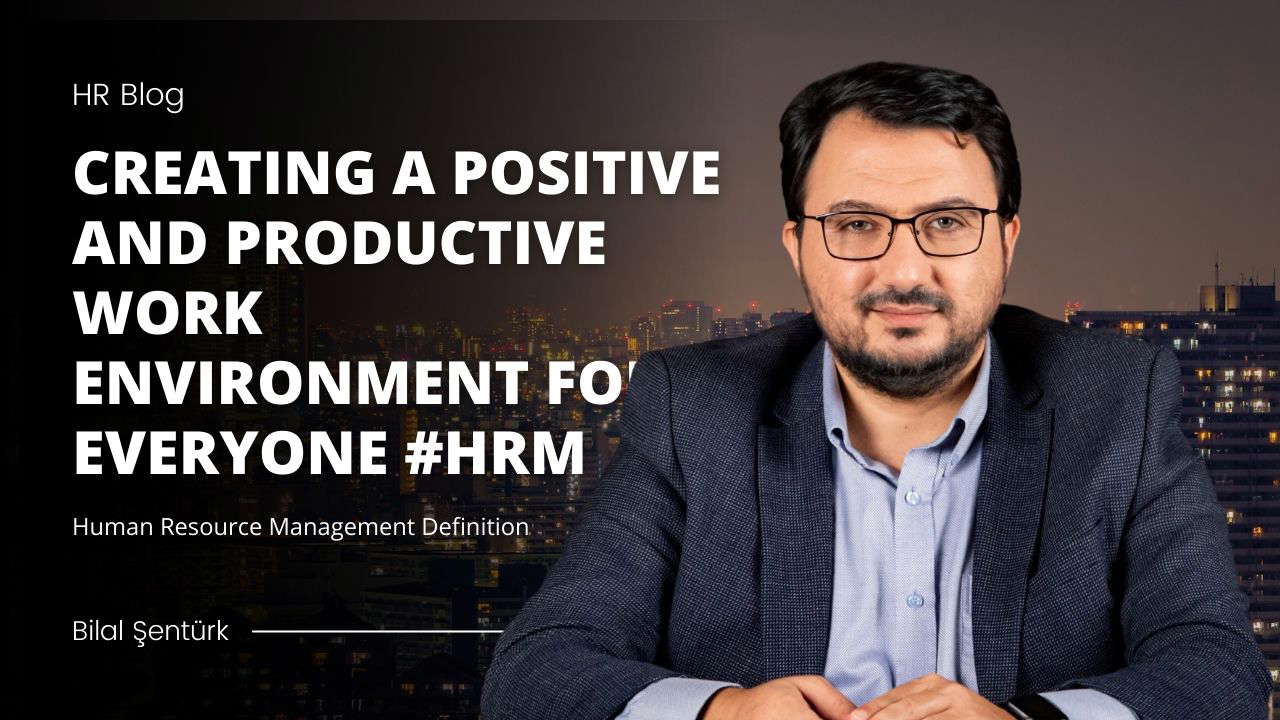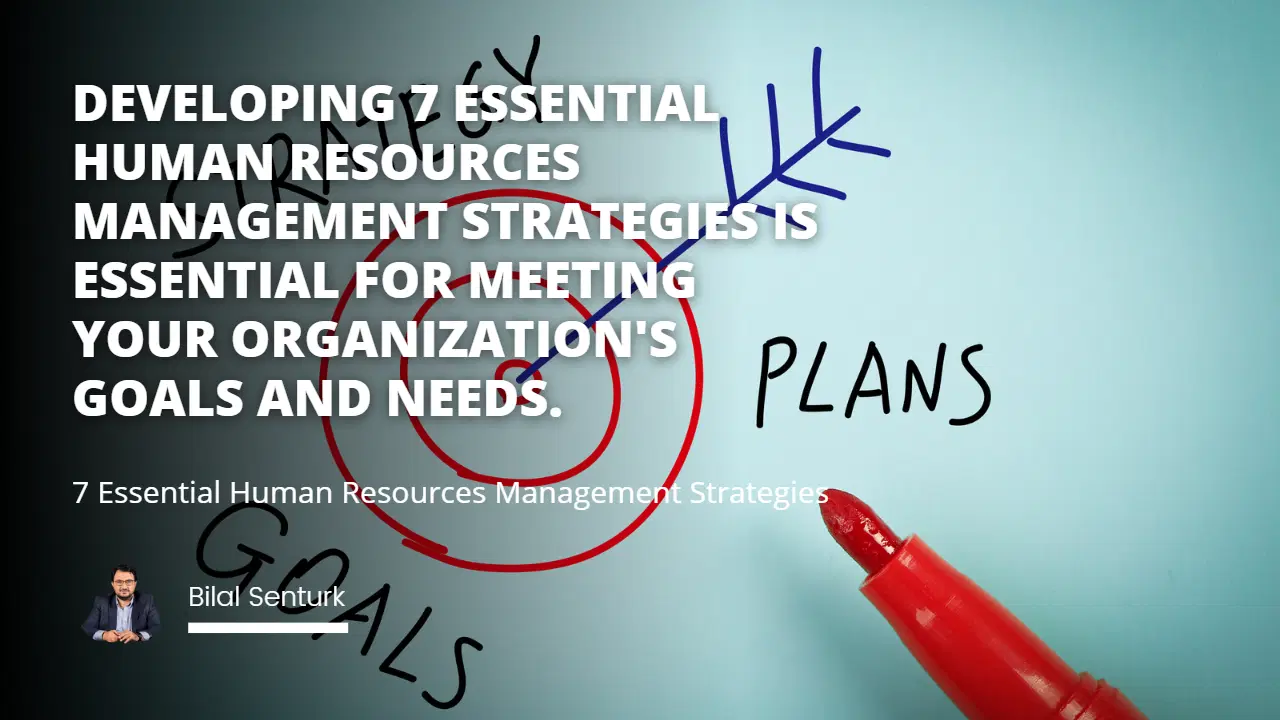
If you're in charge of human resources management, you know it's a complex and demanding job. There are a lot of strategies and approaches you can take to ensure that your team is productive and happy, but what are the most essential?
In this blog post, we'll explore 7 human resources management strategies essential for any HR manager. From building a positive company culture to properly managing employee performance, these tips will help keep your team on track. Read on to learn more!
Related Course: Human Resources Management Course
The Most Important 7 Human Resources Management Strategies
Human resources management is a critical component of success for any business. You can ensure that your company's workforce fuels growth and prosperity with the right strategies.
Here are seven essential HR techniques to prioritize today.
1 - Hiring the right employees
An effective human resources management strategy starts with the crucial task of hiring the right employees.
Focusing on this aspect of HR Management will often result in a successful and productive workplace that encourages employee satisfaction and successful business outcomes.
Different assessment methods, such as online tests, interviews, and structured reference checks, can help ensure applicants have the necessary skills and experience to do the job. In addition, taking the required steps when searching for new staff members ensures long-term growth and success.
Related Course: Human Resources Development (HRD)
2 - Training and development
Training and development is an essential human resources management strategy that allows for continued employee performance and growth improvement.
By investing in the learning and development of its employees, organizations can ensure that their staff stay up-to-date on best practices and promote a culture of knowledge sharing, collaboration, and creativity within the workplace.
Conversely, companies that do not invest in training and development are at a disadvantage as they are less likely to attract top Talent and consequently may experience a decline in their ability to compete against other firms effectively.
In addition, training and development programs can help companies save costs while increasing productivity, so it is vital to prioritize these efforts.
3 - Performance management
Performance Management is a human resource management strategy designed to improve an organization's quality and effectiveness by utilizing its employees' talent and skills. It assesses job performance against organizational goals, sets individual productivity standards, and looks for ways for individuals to reach those goals.
Moreover, it provides feedback to managers and workers on how personal achievement affects the company's overall performance. In addition, performance management helps create and maintain consistent expectations from each employee so that an organization can achieve its desired outcomes as efficiently as possible.
4 - Compensation and benefits
Compensation and benefits form an integral part of human resources management strategy. It is how an organization rewards employees for their hard work, loyalty, and dedication to the company. Because of this, organizations need to ensure their compensation and benefits packages can attract top talent from the industry.
Additionally, these packages must be structured to emphasize fair remuneration based on job importance or seniority to reward employees for their efforts. A flourishing human resources management strategy relies heavily upon a comprehensive system of compensation and benefits that fairly rewards employees' efforts.
5 - Employee relations
Employee relations are an essential component of any successful human resources management strategy.
Taking the time to understand employee wants, needs, and motivations in both a professional and personal setting can do wonders for workplace culture, morale, and overall productivity. In addition, developing meaningful relationships with the team can help managers better understand their staff and get insight into how they respond to different things.
Furthermore, strong communication between managers and employees is critical in creating trust, fostering transparency, identifying improvement areas, and resolving any conflicts that may arise quickly and effectively. Overall, quality employee relations can go a long way toward achieving success in any workplace.
6 - Health and Safety
Ensuring the health and safety of employees should be at the top of any human resources management strategy. Taking steps to create a safe work environment free from hazardous situations and without any potential for dAnger is an integral part of company success.
Developing a work doggedly-based safety program, providing appropriate training and equipment, carrying out pre-employment screening, and strictly maintaining proper health records are all critical aspects in facilitating a healthy, safe workplace for everyone.
Employers must take their responsibilities seriously when protecting their employees from harm. Ensuring "safety" remains a core value in any human resources management strategy.
7 - Diversity and inclusion
Diversity and inclusion are other critical strategies for human resources management. This involves creating a welcoming and inclusive workplace for all employees, regardless of their background or identity.
How to learn human resources management strategy
Human resource is a critical function in any organization. It can help an organization attract and keep the best employees, provide training and development opportunities, manage employee performance, and ensure that employees are compensated fairly and treated equitably.
If you're interested in pursuing a career in human resources or want to learn more about managing people effectively, consider joining the human resources courses at IIENSTITU, we offer a variety of courses that will teach you everything you need to know about HR so you can make the most positive impact on your workplace.
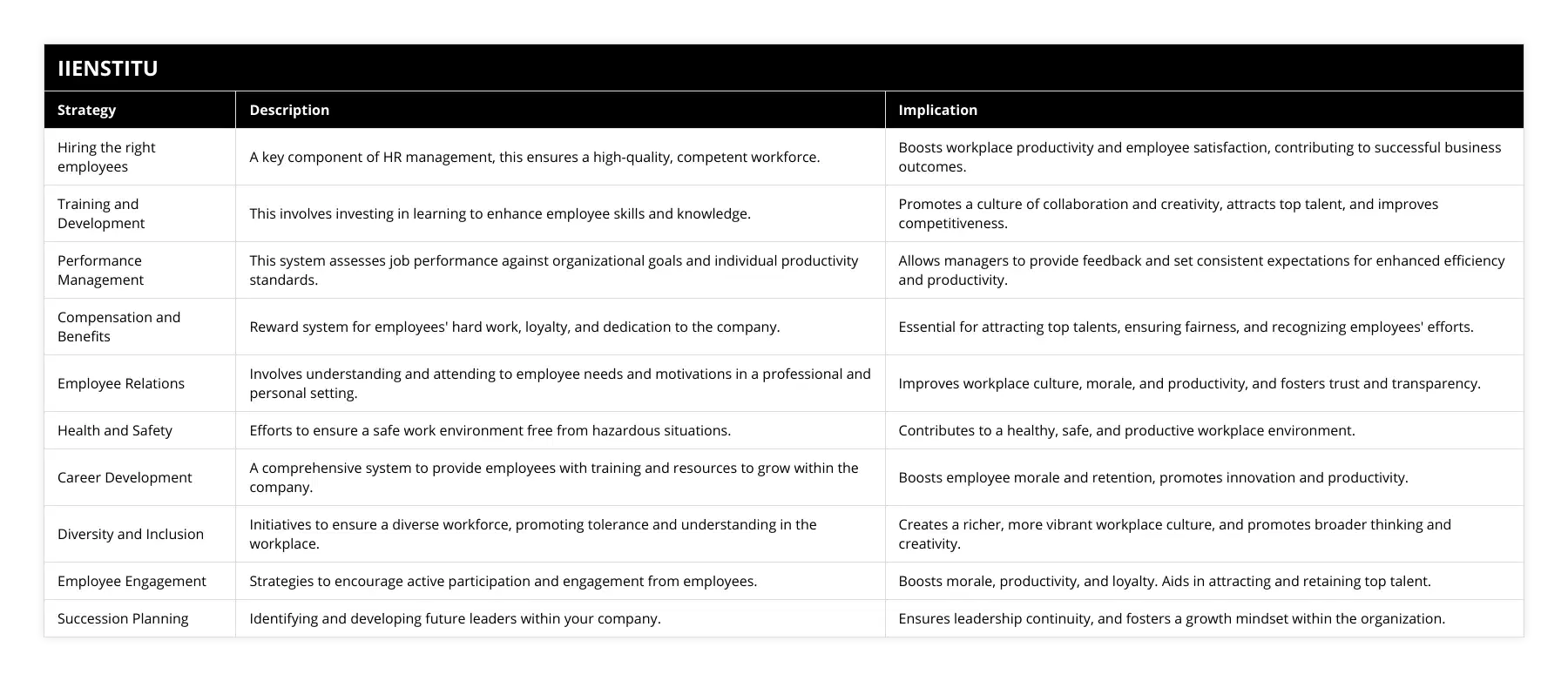
Frequently Asked Questions
What are the essential strategies for human resources management?
Human resources management strategies are essential for ensuring the success of any organization. Recruiting highly skilled and experienced staff, alongside practical training and development initiatives, is integral to organizational growth.
A robust human resources process must foster a positive work environment to ensure employees feel included and valued.
Companies should also incorporate measures that enable staff members to develop professionally with the necessary support and encouragement. By following human resources management strategies, organizations can create an efficient HR process that encourages optimal performance from their human capital - leading to more tremendous success overall.
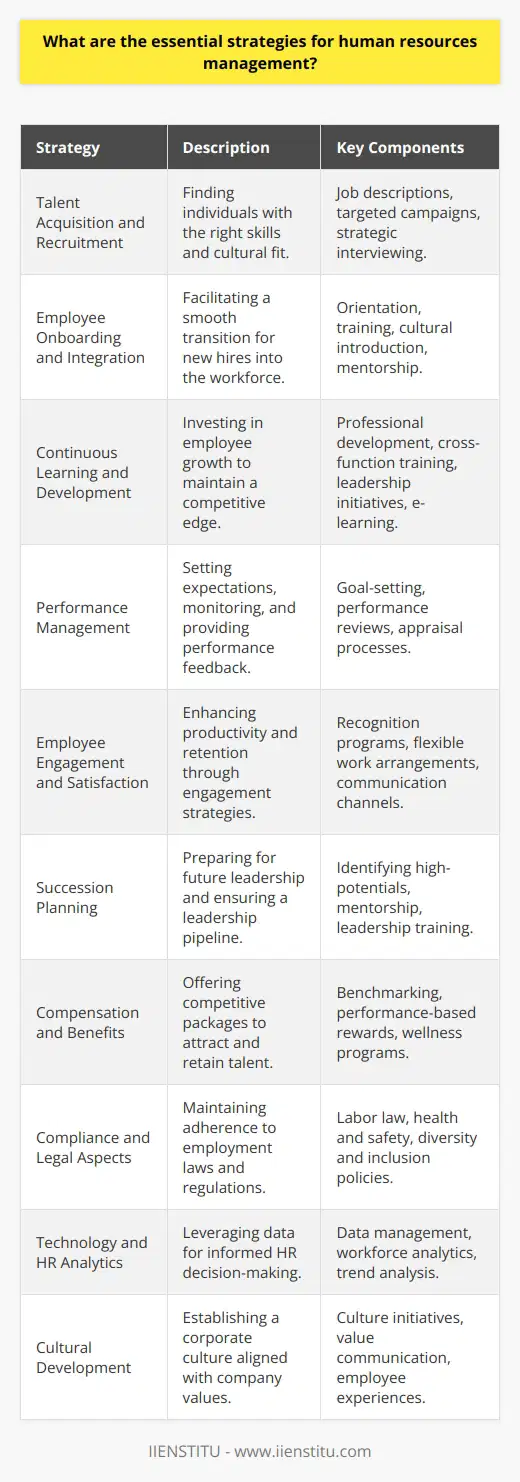
What are some best practices for human resources management?
Human Resources (HR) management is essential to establishing and maintaining a competitive and productive organization.
By staying updated with the latest HR strategies, businesses can ensure that recruitment processes are optimized and that employees can access opportunities such as training and collaboration within the workplace. Together, these human resources management strategies empower team members with the tools they need to succeed in their roles.
As a result, you can foster an environment where everyone thrives.
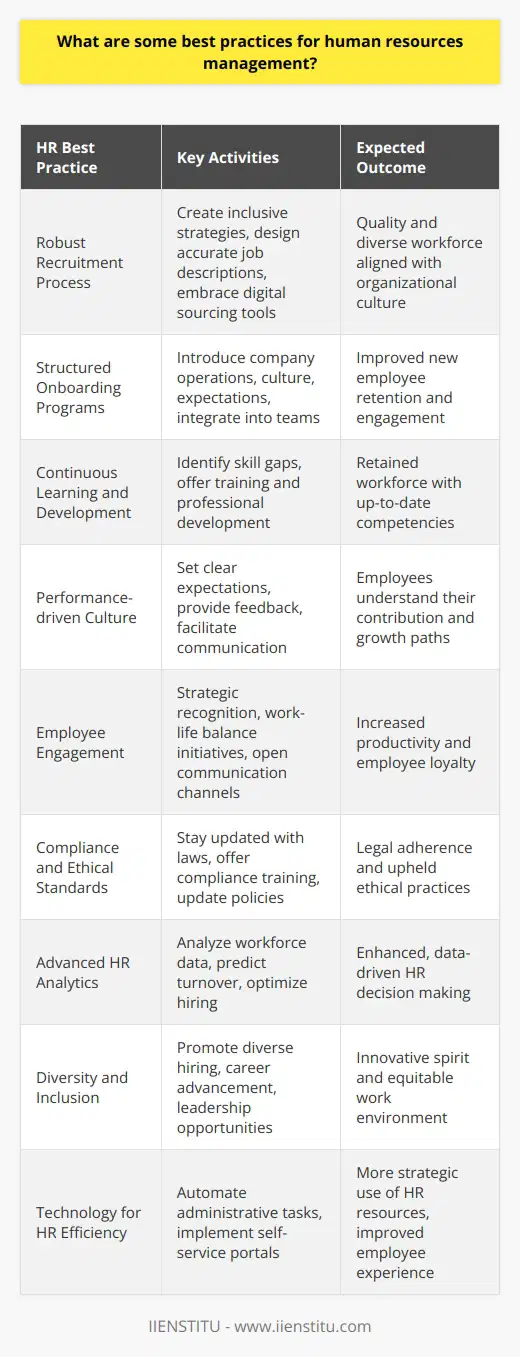
What are some common challenges with human resources management?
Human resources management is complex and demands a multifaceted approach to ensure organizational success. Human resources management strategies must be developed to balance the demands of recruiting and retaining qualified staff, creating an engaged workplace culture, optimizing employee benefits packages, and remaining compliant with labor laws.
In addition, such strategies promote fairness for both employees and businesses alike, taking into account the human element of the organization.
By implementing human resources management strategies that address these issues, organizations can create an atmosphere conducive to long-term success for all stakeholders.
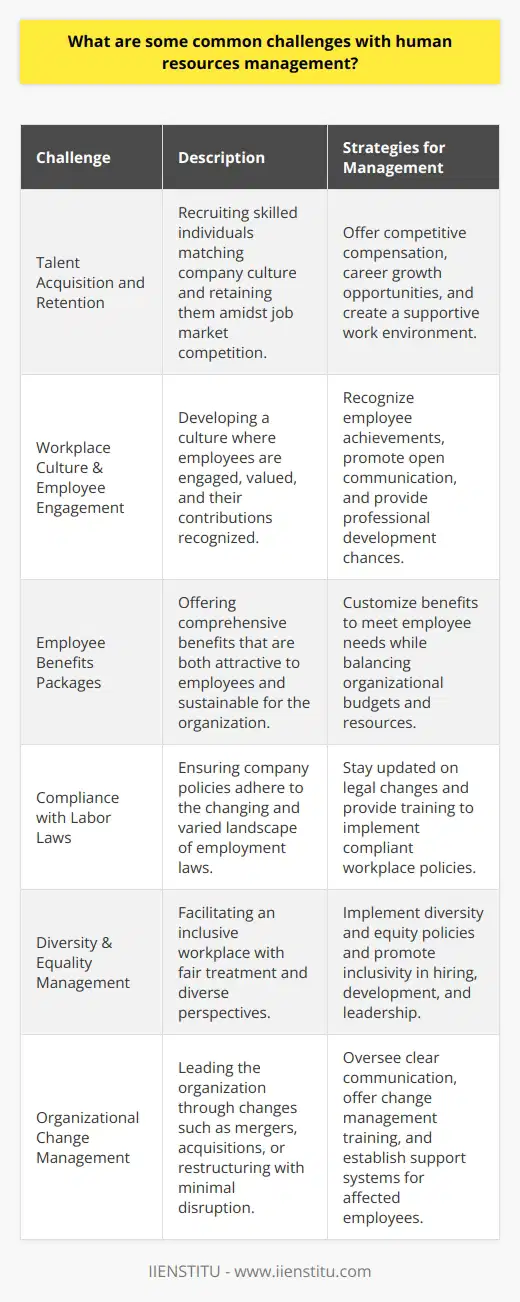
How can I ensure that my human resources management strategies are up-to-date?
Research current trends in human resources management strategies.
Analyze your current human resources management strategies and identify areas for improvement.
Consult with industry experts and other professionals to gain insight into best practices.
Develop a plan to implement new strategies and update existing ones.
Monitor performance and adjust strategies as needed.
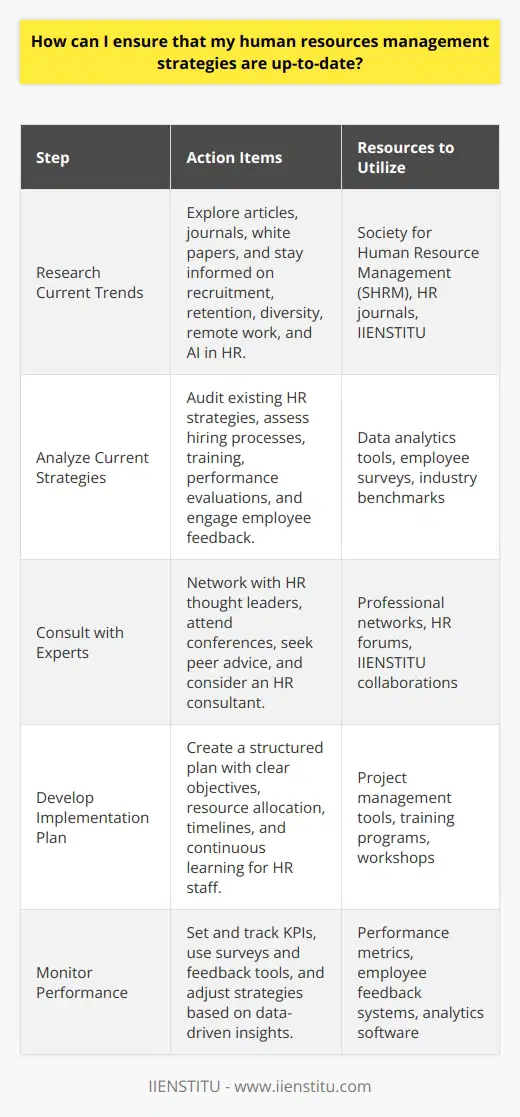
How can I use technology to improve my human resources management strategies?
Automate your recruitment process: Use an automated applicant tracking system to streamline the recruitment process, from job postings and candidate tracking to onboarding and reporting.
Implement an employee engagement platform: An employee engagement platform can help you capture feedback from your employees, identify areas for improvement and keep track of employee satisfaction.
Utilize analytics: Utilize data analytics to identify trends and patterns in employee performance, and use the insights to create effective HR strategies.
Invest in HR software: Invest in HR software to streamline administrative processes, such as payroll, scheduling, leave management and time tracking.
Introduce virtual onboarding: Use virtual onboarding to ensure smooth onboarding processes for remote employees, and ensure they have access to the information and resources they need.
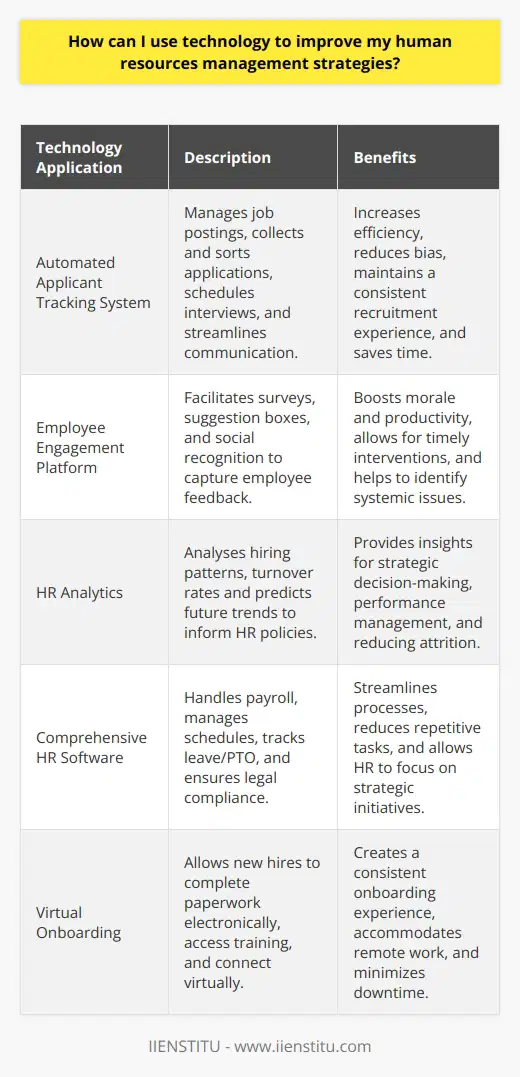
What are the key elements of a successful human resources management strategy?
Developing a Vision and Strategic Plan: Establishing a vision for the Human Resources (HR) department and creating a strategic plan to meet organizational goals.
Recruiting and Retaining Talent: Attracting and recruiting the best talent and fostering an environment that encourages employees to stay.
Training and Development: Offering employees the opportunity to enhance their skills and knowledge, as well as their performance.
Compensation and Benefits: Designing and implementing a competitive compensation and benefits package for employees.
Performance Management: Establishing and monitoring performance goals, as well as providing feedback and recognition to help employees improve.
Employee Relations: Cultivating strong relationships with employees to ensure they feel valued and supported.
Compliance: Ensuring compliance with labor laws, regulations, and policies.
Organizational Culture: Creating and nurturing a positive organizational culture that encourages collaboration, innovation, and employee engagement.
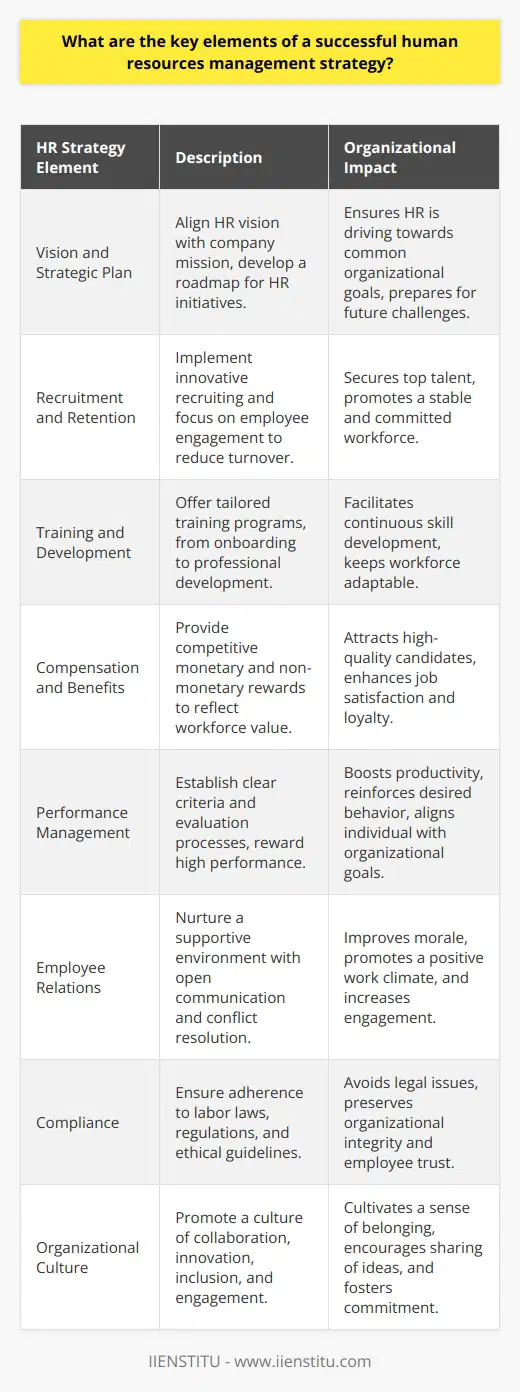
What are the implications of the 7 steps to strategic human resource management in achieving an organization's goals?
**Strategic Alignment**
The implications of the 7 steps to strategic human resource management (SHRM) in achieving an organization's goals can be observed through various factors. Firstly, it aligns the human resource (HR) function with the overall organizational strategy, ensuring all objectives and initiatives are in harmony with the company's vision and mission. This results in improved communication and direction for the employees, enabling them to focus on the implementation of relevant tasks that contribute to the company's success.
**Recruitment and Selection**
SHRM's second step emphasizes recruitment and selection, which plays a significant role in achieving an organization's goals. By attracting and retaining talented professionals, companies can strive for high employee performance, better problem-solving capacity, and innovative ideas. This ultimately enhances organizational competitiveness and ensures the fulfillment of desired objectives.
**Performance Management**
The effective implementation of performance management strategies helps promote a results-oriented culture within the organization. It incentivizes employees to achieve their individual goals while simultaneously benefiting the organization. Monitoring this progress and providing constructive feedback ensures that employees maintain their focus on attaining the company's strategic objectives.
**Employee Development**
Continuous employee development boosts workforce competencies and adaptability to changing business environments. By investing in training, skill development, and career growth opportunities, HR can encourage employees to remain committed and loyal to their employer. Consequently, this ensures that the organization has a pool of skilled professionals to achieve its goals and maintain its competitive advantage.
**Employee Engagement**
Employee engagement directly influences organizational outcomes such as productivity, employee retention, and profitability. With the help of strategic HR initiatives, organizations can foster a strong emotional connection between employees and their work, motivating them to fulfill strategic objectives. A satisfied and engaged workforce is more likely to contribute their best efforts, resulting in the achievement of organizational goals.
**Compensation and Benefits**
A well-designed compensation and benefit package is crucial to attract, retain and motivate talented employees. By offering competitive pay, enticing bonuses, and appealing benefits, organizations can demonstrate their commitment to employees' well-being. This ultimately enhances the organization’s ability to effectively achieve its goals, by ensuring the workforce stays motivated and focused on delivering results.
**Legal Compliance and Risk Management**
Lastly, the 7-step SHRM approach helps to ensure compliance with legal and regulatory requirements, reducing the likelihood of costly violations and fines. By mitigating potential risks, organizations can protect their reputation, maintain employee trust, and avoid distractions that could impede the achievement of their goals.
In summary, the 7 steps to strategic human resource management play a substantial role in achieving an organization's goals. By aligning HR operations with the company's strategic objectives, the HR function becomes a critical business partner for success. This partnership contributes to organizational growth, efficiency, and profitability.
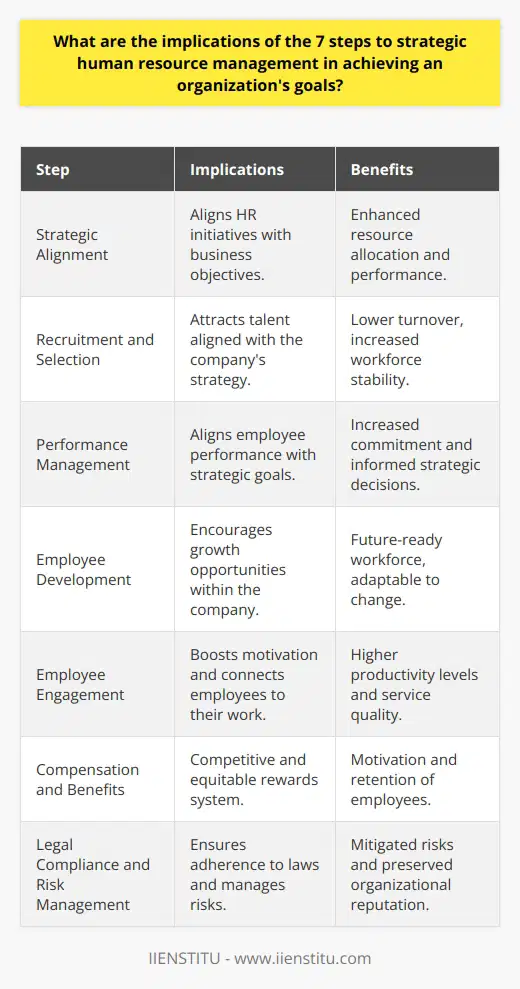
How can the 7 principles of human resource management contribute to the ethical practices within a company?
Incorporating Ethical Practices through HRM Principles
Enhanced Ethical Decision-Making
The seven principles of human resource management (HRM) can contribute significantly to the ethical practices within a company. Firstly, by adhering to the value of fair and equitable treatment, HRM promotes unbiased decision-making throughout the organization. This principle ensures that all employees are treated with respect and dignity, regardless of their background or position, fostering an ethical work environment.
Promoting Transparency
Secondly, transparency and openness are vital principles in HRM that encourage ethical practices. By fostering clear communication channels and ensuring relevant information is accessible, HRM can deter potential unethical practices such as withholding or manipulation of information, thereby maintaining trust among stakeholders.
Establishing Accountability
Principle three, accountability, ensures that individuals are held responsible for their actions and decisions. Instilling a culture of accountability within the organization drives employees to act ethically, knowing that there will be consequences for any misconduct.
Fostering Inclusivity
The fourth principle centers on diversity and inclusion, which encourages the celebration of differences within the company. By promoting a diverse workforce, HRM ensures that diverse perspectives and values are integrated into the company's decision-making, fostering an environment where ethical practices thrive.
Upholding Compliance
Adhering to legislative compliance, the fifth principle, safeguards the company from legal issues and potential reputational damage stemming from unethical practices. By implementing and monitoring adherence to various laws and regulations, HRM can ensure the organization operates ethically and responsibly.
Prioritizing Employee Well-Being
The sixth principle focuses on employee well-being and work-life balance. HRM's commitment to creating supportive work environments and promoting overall employee welfare encourages individuals to act responsibly and ethically, knowing that their well-being is valued within the organization.
Implementing Ethical Leadership
Lastly, the seventh principle entails ethical leadership, which involves HRM fostering a culture where leaders lead by example and embody ethical values. Instilling ethical leadership within the organization inspires employees to uphold these values and contribute to establishing an ethical company culture.
In conclusion, the seven principles of human resource management significantly contribute to ethical practices within a company. By promoting fairness, transparency, accountability, diversity, compliance, employee well-being, and ethical leadership, HRM facilitates the creation of a working environment where ethical behavior is not only encouraged but also rewarded.

In what ways can the 7 important steps related to the human resource cycle streamline the overall talent management process?
Understanding the Human Resource Cycle
The human resource cycle is a systematic process that enables organizations to integrate various aspects of talent management effectively. It comprises seven essential steps to streamline the process and facilitate a smooth flow of tasks linked to employees' performance and growth. Understanding each of these steps and their roles in the talent management process will elucidate how they enhance overall efficiency.
Recruitment and Selection
The first step, which involves finding and hiring the best talent, directly impacts the organization's performance. By adopting strategic recruitment and selection processes, companies can ensure that they employ skilled individuals who align with their objectives and values, thereby reducing turnover and fostering employee satisfaction.
Onboarding and Orientation
This step is crucial in ensuring new employees understand their roles and responsibilities while integrating them into the organizational culture. A thorough onboarding and orientation process helps in smoothening the transition, addressing potential issues early on, and promoting employee engagement, contributing to long-term retention and success.
Training and Development
Continuous training and development are vital in fostering employees' professional growth and enhancing their skill sets. By implementing comprehensive training programs and tapping into employees' potential, organizations can benefit from improved performance, increased productivity, and the ability to adapt to changing market demands.
Performance Management
Monitoring and evaluating employees' performance ensures that teams stay focused on meeting organizational goals. A robust performance management system enables quick identification of underperformance, allows for timely feedback and support, and, ultimately, boosts productivity as employees are held accountable for their results.
Compensation and Benefits
Fair and competitive compensation packages, coupled with benefits such as health insurance and professional development opportunities, play a crucial role in retaining top talent. By rewarding employees based on performance, organizations create a merit-based system that motivates individuals to strive for excellence.
Employee Retention Strategies
Implementing effective retention strategies, such as employee recognition and flexible work environments, help organizations foster a positive work culture and prevent loss of valuable talent. By actively addressing employees' needs and concerns, companies can maintain a loyal and committed workforce, reducing the costs associated with employee turnover.
Offboarding and Succession Planning
The final stage in the human resource cycle involves strategically managing employees' departure while ensuring the transfer of knowledge and seamless continuation of operations. By creating a robust succession plan, organizations can quickly and efficiently replace departing talent with minimal disruption to business processes.
In conclusion, the seven steps related to the human resource cycle contribute significantly to streamlining the overall talent management process by enhancing each stage of an employee's lifecycle within the organization. From recruitment and selection to offboarding and succession planning, these steps ensure the efficient management of human capital, fostering a high-performing and engaged workforce.
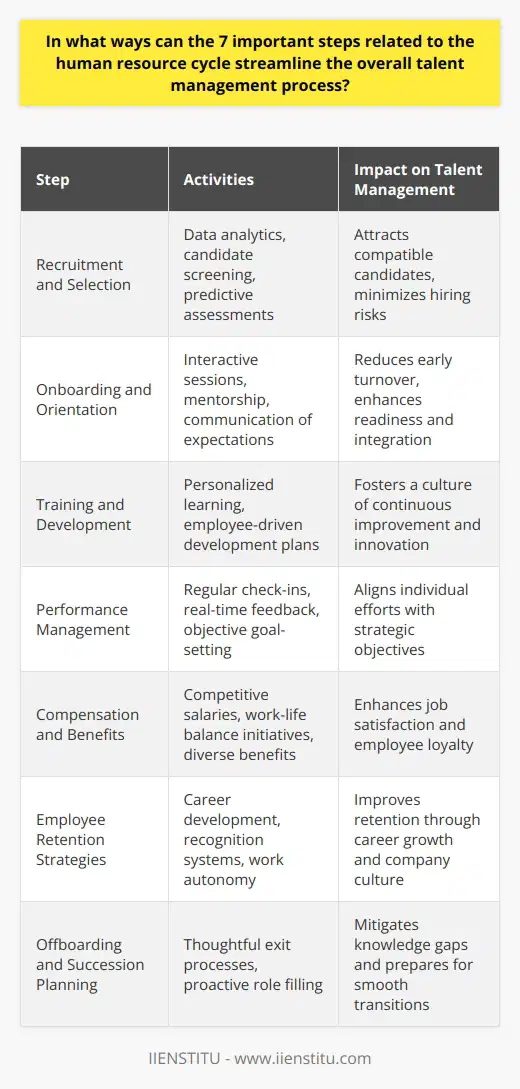
What are the key components of the 7 steps to strategic human resource management and how do they influence organizational success?
Identifying Key Components
The key components in the seven steps to strategic human resource management (SHRM) are crucial for creating and sustaining a thriving organization. These components are as follows:
Aligning HR Strategy with Organizational Goals
Linking human resource strategy with organizational objectives ensures that the workforce contributes to the achievement of these goals, thereby fostering the organization's success.
Workforce Planning and Talent Acquisition
Workforce planning involves assessing the organization's current skills, knowledge, and abilities while identifying future workforce needs. Talent acquisition strategies, in turn, bring in the most suitable employees to address these needs, positively impacting organizational performance.
Performance Management
Effective performance management systems help organizations assess employee performance, identify development opportunities, and set individual and team goals. Consequently, it drives productivity and, ultimately, organizational success.
Employee Training and Development Programs
Continuous investment in employee training and development enhances their skills, knowledge, and abilities, fostering innovative thinking, improvements in processes, and overall growth of the organization.
Rewards and Compensation
Offering competitive rewards and compensation packages motivate employees to perform at their best and align their efforts with organizational objectives. This strategic alignment translates to increased productivity and success.
Establishing a Positive Work Environment
A positive work environment fosters a culture of collaboration, creativity, and innovation. When employees feel valued, supported, and recognized, they feel empowered to contribute towards organizational success.
Monitoring and Continuous Improvement
Regular monitoring and evaluation of SHRM processes and practices allow organizations to identify areas of improvement, ensuring they stay ahead of their competition and continuously progress towards strategic goals.
Influence on Organizational Success
By executing these seven critical components effectively, organizations can use SHRM as a competitive advantage. Aligning human resource strategies with organizational goals empowers employees, attracts top talent, enhances performance, and cultivates a positive work culture. Moreover, this strategic approach ensures continuous improvement and adaptability, which are vital for long-term success in today's dynamic business landscape. In summary, the effective implementation of SHRM plays a crucial role in driving organizational success, emphasizing the importance of investing in human capital development.
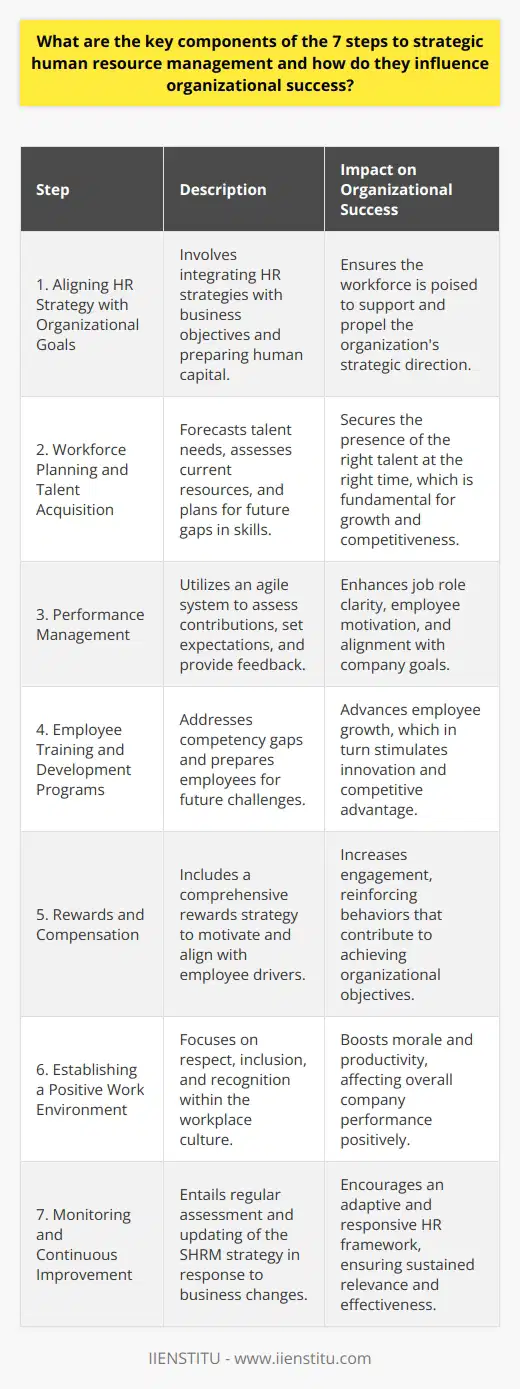
How do the 7 principles of human resource management help in fostering a positive organizational culture and employee satisfaction?
Effect of HRM Principles on Organizational Culture
The seven principles of human resource management (HRM) significantly contribute to cultivating a positive organizational culture and enhancing employee satisfaction. These principles act as a blueprint for organizations to create a nurturing work environment.
Employee Empowerment
The first principle incorporates empowering employees, which means granting them decision-making authority and fostering their skills. This sense of empowerment enhances their job satisfaction, leading to a flourishing organizational culture.
Fair and Competitive Compensation
Equitable and competitive compensation is essential to keep employees engaged and motivated. By adhering to this HRM principle, organizations can ensure that their workforce is satisfied and stays committed to their work.
Training and Development Opportunities
The provision of continuous learning and development opportunities allows employees to grow professionally. These opportunities not only improve job performance but also contribute to employees' sense of accomplishment and contentment.
Inclusive Communication
Effectively communicating with employees is crucial for maintaining a positive work environment. Open and inclusive communication facilitates a better understanding of expectations, objectives, and goals, and increases employee satisfaction.
Equal Employment Opportunities
Equal opportunities for all employees regardless of their gender, ethnicity, or other distinguishing attributes promote a fair work environment. This inclusivity enriches the organization's culture and fosters a sense of belonging among the workforce.
Safety and Health Management
A safe and healthy work environment is a fundamental aspect that impacts employees' well-being and job satisfaction levels. By adhering to safety protocols and regulations, organizations can create a culture where employees feel secure and valued.
Performance Management and Recognition
Last but not least, effective performance management and recognition of employees' efforts play a key role in boosting their satisfaction. By offering timely feedback and celebrating achievements, organizations can foster positive employee morale and a supportive work culture.
In conclusion, the seven principles of HRM are essential in establishing a vibrant and conducive work environment. These tenets ensure that employees feel valued, motivated, and engaged, leading to their overall satisfaction and the creation of a thriving organizational culture.
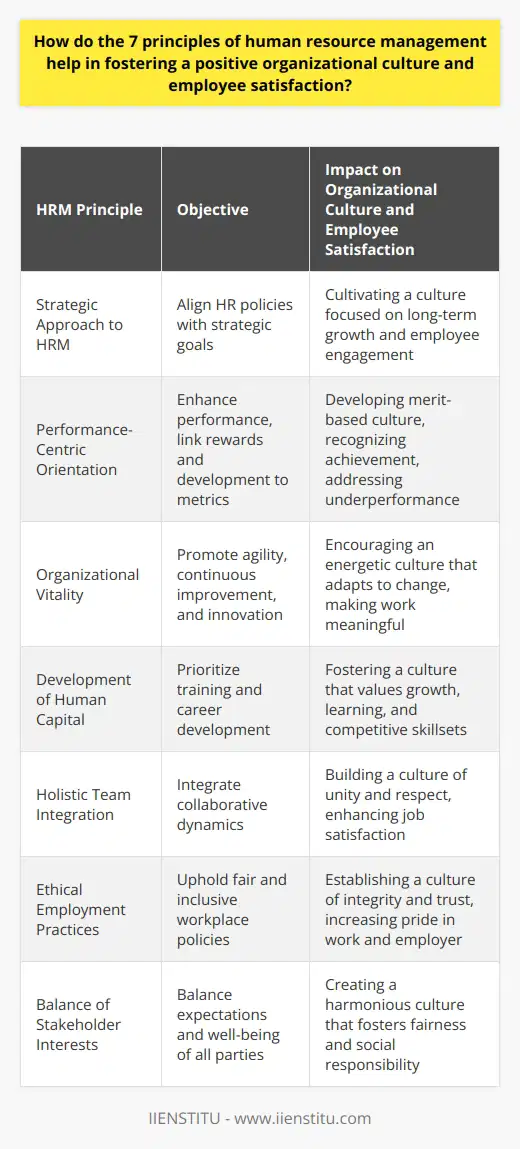
How can an organization efficiently implement the 7 important steps related to the human resource cycle to enhance its talent acquisition and retention strategies?
Understanding the Human Resource Cycle
To enhance its talent acquisition and retention strategies, an organization can efficiently implement the seven important steps related to the human resource cycle. The Human resource (HR) cycle is a systematic process that entails strategic planning, recruitment, onboarding, performance management, remuneration, and offboarding.
Strategic Planning and Forecasting
The first step involves planning and forecasting, which entails outlining the organization's future manpower requirements. This is crucial in identifying potential gaps in the workforce and aligning them with its overall objectives.
Recruitment and Selection
An effective recruitment and selection process is essential to attract and choose the right candidates for a job. This involves advertising job vacancies, reviewing applications, conducting interviews, and selecting the most suitable candidates to join the organization.
Onboarding and Orientation
Onboarding is an essential part of the HR cycle, during which new employees become familiar with the organization's culture and values. This process typically includes providing information about the organization, job expectations, and providing support for employees to adapt to their new work environment.
Performance Management
Managing employee performance is crucial in ensuring organizational goals are met. This involves setting individual performance expectations, providing feedback, and offering opportunities for growth and development. By fostering an environment centered on continuous improvement, organizations encourage employees to reach their full potential.
Employee Remuneration
Compensation and benefits play a significant role in attracting and retaining employees. By offering competitive salary packages, organizations show that they value their employees' skillsets and contributions. It is essential to regularly review and update remuneration policies to remain competitive in the market.
Offboarding and Succession Planning
Offboarding refers to the process of managing employee exits, whether voluntary or involuntary. This includes conducting exit interviews, managing knowledge transfer, and updating organizational records. Meanwhile, succession planning allows organizations to prepare for ongoing and anticipated vacancies in key positions, ensuring a seamless transition to maintain productivity and efficiency.
Continuous Improvement and Evaluation
The final step is to evaluate the effectiveness of the human resource cycle continually. This involves gathering employee feedback, analyzing HR data, and identifying areas for improvement. By refining the entire cycle, organizations can ensure that their talent acquisition and retention strategies remain competitive and effective.
In conclusion, an organization can efficiently implement the seven essential steps of the HR cycle to enhance its talent acquisition and retention strategies. By understanding and applying those concepts, organizations can attract, develop, and retain the best talent to drive business success.
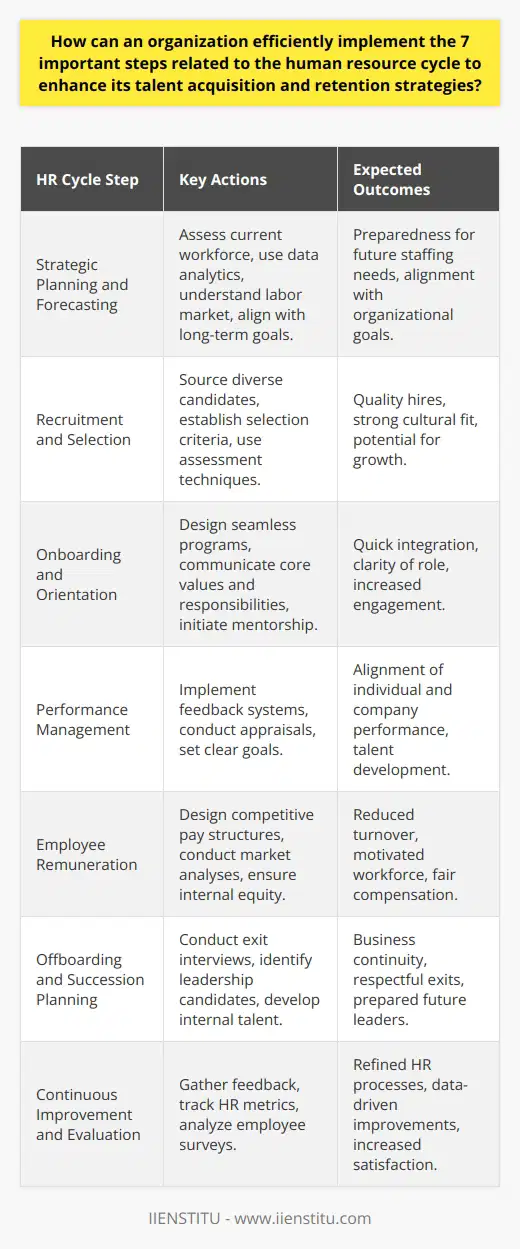
What are the key differences between the 5 core principles of HR and the 7 principles of human resource management, and how do these principles complement each other in practice?
Key Differences Between HR Principles
The primary distinctions between the five core principles of Human Resources (HR) and the seven principles of Human Resource Management (HRM) lie in their emphasis on strategic integration, employee commitment, communication, and development.
Strategic Integration and Employee Commitment
The five core principles of HR focus on promoting employee engagement, good working conditions, diversity management, and employee health and well-being. These principles mainly emphasize the employees' needs rather than the overall organization's objectives, which the seven principles of HRM prioritize. Specifically, HRM principles include strategic integration, organizational performance, employee involvement, and continuous improvement, demonstrating the goal-oriented nature of HRM principles.
Communication and Development
Additionally, the HR principles emphasize effective communication, feedback mechanisms, and clear performance expectations. In contrast, HRM principles focus on employee growth and development, fostering skill enhancement, and offering opportunities for career advancement. This direct investment in employees' professional development embodies the HRM approach's long-term orientation.
Complementary Nature of the Principles
Despite these differences, the principles of both HR and HRM complement each other in practice. The five core HR principles contribute to creating a strong foundation for employee satisfaction and a healthy work environment. In turn, this fosters the successful implementation of the seven HRM principles, which target strategic and organizational goals. Consequently, by leveraging the strengths of both sets of principles, organizations benefit from increased employee engagement, satisfaction, and ultimately, better overall performance.
In conclusion, the key differences between the five core principles of HR and the seven principles of HRM stem from their respective focuses on individual employees' needs and organizational objectives. However, these principles complement each other when applied in practice, leading to more cohesive and effective HR efforts within an organization.

How do the seven main functions of the human resources department interact with one another to contribute to an organization's effectiveness and efficiency?
Functions and Interconnectivity in HR
Human resources (HR) plays a vital role in the efficiency and effectiveness of an organization. The seven main functions of HR interact harmoniously to create a dynamic and cohesive environment.
Recruitment and Retention
One of the primary functions is recruitment and retention, ensuring a steady flow of talented individuals to help the organization grow. This function involves the proper advertising of vacancies, screening of potential candidates, and providing the necessary training after their onboarding. With a strong workforce, the organization can better achieve its goals.
Performance Management
To maintain productivity, HR engages in performance management. This function evaluates employees' performance periodically, sharing constructive feedback and identifying areas for advancement. Performance management helps set targets and encourages a culture of continuous improvement and collaboration across the organization.
Employee Benefits and Compensation
Ensuring competitive benefits and compensation is another vital task for HR. This function attracts and retains top talent, motivating employees to maintain high performance. A well-crafted benefits package has a direct impact on employee satisfaction, which in turn can boost efficiency and enhance the company's reputation.
Training and Development
Employee training and development efforts ensure workers are well-equipped to meet various job requirements and adapt to changes in the market. Continuous learning initiatives also retain employees by offering growth and upskilling opportunities, benefiting the organization in the long run.
Regulatory Compliance
Compliance with employment laws and regulations is crucial not only for legal reasons but also for establishing trust and ethical practices. HR safeguards the rights of both employees and employers, which bolsters a positive working atmosphere where everyone is aware of their duties and obligations.
Workplace Health and Safety
Creating a safe work environment is a primary responsibility of HR. Implementing safety protocols and offering relevant training helps protect employees from potential hazards, contributing to a more streamlined operation and reduced costs that may accrue due to accidents or workplace issues.
Conflict Resolution and Employee Relations
Finally, HR facilitates conflict resolution and maintains positive employee relations by addressing individual or team issues effectively. By fostering a collaborative environment with open communication channels, the HR department ensures a nurturing workspace, leading to higher performance and productivity.
In conclusion, each of the seven primary functions of HR synergistically contributes to an organization's effectiveness and efficiency. By developing talent, ensuring compliance, and fostering a supportive work environment, HR plays a vital role in driving an organization towards success.

In which ways can an organization adopt and adapt the 7 steps to strategic human resource management to optimize workforce performance and productivity?
Aligning Organizational Objectives and HRM Strategy
An organization can adopt the 7 steps to strategic human resource management to optimize workforce performance and productivity by first aligning its organizational objectives and human resource management (HRM) strategy. This involves linking HR activities and decisions to the organization's strategic goals to enhance efficiency and effectiveness. By doing this, organizations ensure that the HRM strategy complements and reinforces the overall business strategy.
Employee Recruitment and Selection
In the second step, organizations must implement effective recruitment and selection processes to attract, identify, and choose suitable candidates for various positions. By doing this, they ensure that the workforce possesses the necessary skills, knowledge, and experience for increased productivity. Rigorous interviews, assessments, and background checks can be used to increase the likelihood that newly hired employees will contribute positively to the organization.
Training and Development
Thirdly, organizations must invest in training and development, enabling employees to attain new competencies and skills needed for their current and future roles. Training programs can be designed to address specific gaps in workers' abilities or to prepare them for upcoming assignments or leadership positions. Continuous learning and development initiatives can greatly improve workforce productivity and enhance overall organizational performance.
Performance Management
The fourth step involves implementing a robust performance management system, enabling organizations to measure, evaluate, and improve employee performance. This system should be designed to assess performance against set goals and provide feedback to help employees grow professionally and address areas that need improvement. Performance management tools are crucial for identifying high-performing employees, setting performance expectations, and ensuring that the workforce is focused on reaching the organization's goals.
Reward and Recognition
Fifthly, organizations must establish a rewarding and recognition system that incentivizes employees based on their performance. This creates a performance-driven culture, motivating employees to work harder, smarter, and increase their productivity. Appropriate rewards, such as financial incentives, promotions, recognition programs, and employee development opportunities, help organizations retain top talent and encourage continued engagement.
Succession Planning
The sixth step is to establish a succession planning process, enabling organizations to identify and develop the next generation of leaders. This is an essential part of workforce planning, as it ensures continuity within the organization and creates a pipeline of talented workers who are ready to step into leadership roles when the need arises. It also helps organizations to minimize the disruption caused by unexpected personnel changes, ensuring steady performance and productivity.
Employee Relations and Communication
Finally, organizations must maintain effective employee relations and communication channels, fostering an environment of openness, trust, and collaboration. Good employee relations improve employee satisfaction, engagement, and loyalty. In turn, higher engagement leads to better workforce performance and productivity. Effective communication keeps employees informed about the organization's objectives and expectations, helping to align their work with the organization's strategic goals.
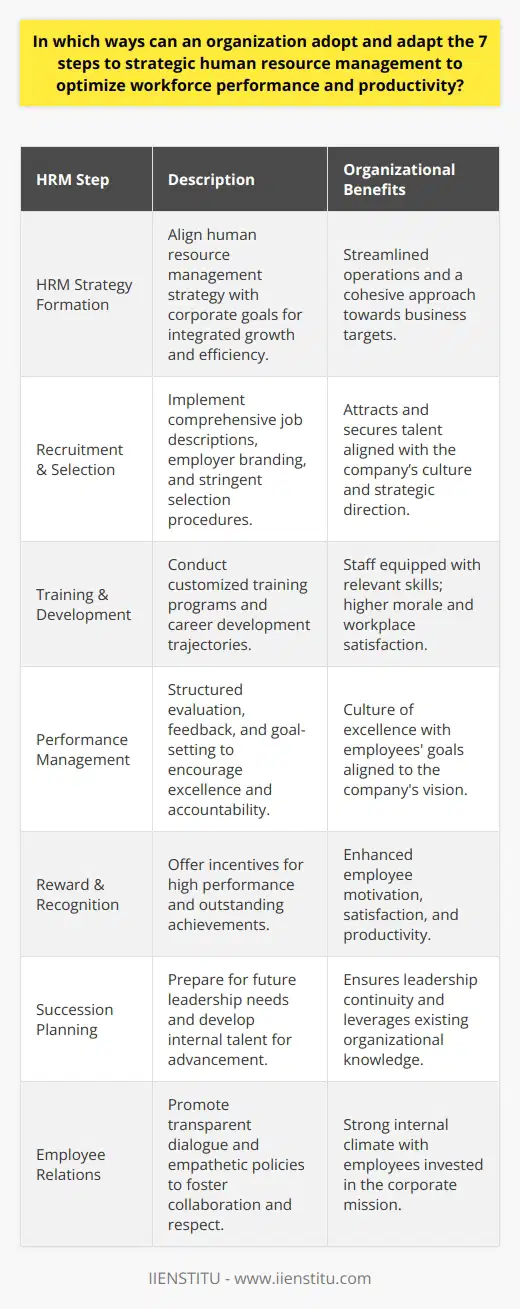
What are the key considerations in implementing the 7 steps to strategic human resource management, and how do they align with an organization's overall business objectives?
Understanding the Organization and Its Context
Strategic human resource management implementation begins with an in-depth understanding of the organization and its context. This entails analyzing the internal and external environments. Factors such as the organization's culture, structure, and business model fall into the internal environment. External environment encompasses industry trends, regulations, and competitors. These analyses align HR policies with business objectives and ensure they respond to the dynamic business environment.
Establishing the HRM Direction
Next, close attention must be conducted on developing the HRM direction. This involves setting the mission, vision, and strategic objectives for the HRM. These should integrate seamlessly with the overall organizational strategy. This alignment ensures HR initiatives drive the organization toward its broader objectives.
Designing the HRM System
The design of the HRM system should be strategically driven. It has to consider key elements such as talent acquisition, training and development, performance management, and compensation. This design should reflect the unique needs and objectives of the organization. An effective HRM system enhances an organization's competitive advantage by optimizing human capital.
Implementing the HRM System
Careful attention must be given when implementing the HRM system. Prioritizing communication is crucial. The intended purpose and benefits of changes should be clear. In this manner, it promotes buy-in from employees, which smoothens implementation.
Evaluating the HRM System
Constructive feedback and constant evaluation of the HRM system bolster successful implementation. The system should be flexible enough for adjustments when necessary. Evaluations ensure alignment with short and long-term organizational objectives.
Continuous Improvement
In a constantly changing business environment, continuous improvement should be a mainstay of strategic human resource management. HRM practices should evolve to match the dynamic business landscape, delivering sustainable competitive advantage.
Conclusion
In conclusion, the implementation of strategic human resource management requires thoughtful consideration. Its alignment with business objectives is a continuous process that demands flexibility and responsiveness to the organization's context. To do this, understanding the organization, setting HRM direction, designing an appropriate system, ensuring effective implementation, ongoing evaluation, and continuous improvement are integral.

How can the 7 basic human resource management principles support diversity and inclusion initiatives within an organization?
Incorporation of Management Principles in Diversity and Inclusion
The seven basic principles of Human Resource Management (HRM), when appropriately applied, can significantly bolster diversity and inclusion initiatives in an organization.
Strategic Approach to People Management
A strategic approach ensures that the organization aligns its diversity and inclusion initiatives with its overarching goals. It aids in incorporating diversity and inclusion into the organizational culture, so it becomes part of its identity.
Employment Relations
Consideration of employment relations ensures a fair framework for addressing diversity discrepancies and cultural sensitivities. This aspect helps in promoting dialogue, ensuring that decision-making processes reflect consensus-based feedback from all employees.
Scientific Selection of Workers
The third principle prescribes the scientific selection and development of workers. This approach can combat unconscious bias - one of the prominent reasons hindering diversity and inclusion in organizations.
Organizational Objectivity
Adherence to objectivity involves fairness in promotions and rewards, fostering a culture of inclusiveness by rewarding merit instead of favoritism.
Employee Development
HRM focuses on developing employees, offering career-enhancement opportunities based on merit rather than nationality, gender, age, or physical attributes, thus promoting diversity.
Effective Collaboration
HRM encourages cooperation and teamwork, which fosters understanding and acceptance among employees of different backgrounds and cultures, enhancing diversity.
Respect for Diversity
Lastly, respect for individual differences, a fundamental HRM principle, directly supports diversity by recognizing the unique contributions of each individual regardless of their background or identity. It recognizes the diversity present and provides an environment for it to flourish.
In conclusion, the seven basic human resource management principles provide a robust framework to support and drive diversity and inclusion initiatives within an organization. They foster an environment that respects and promotes diversity, creating a more inclusive and productive workforce. This response leads to enhanced creativity, innovation, and overall business performance.

What role does effective communication play in executing the seven main functions of the human resources department, and how can HR leaders leverage this skill to enhance employee engagement and satisfaction?
Understanding the Role of Communication in HR Functions
Effective communication forms the backbone for executing various functions of the human resources (HR) department. It primarily aids in recruitment by helping HR professionals correctly convey job requirements to potential candidates. The process of selection, too, depends greatly on communication skills to assess the candidate’s capabilities accurately.
Communication in Employee Development and Appraisals
Clear communication also plays a part in training and development. HR professionals need to explain business goals and employee roles effectively to ensure growth. In performance appraisals, constructive feedback requires tactful communication to encourage improvement without discouraging employees.
Implication of Effective Communication on Employee Wellness
In terms of safety and wellness, HR leaders must communicate policies and concerns openly to promote a sound work environment. Through compensation and benefits management, transparent communication is essential to make employees understand their monetary returns and rewards.
Leveraging Communication for Employee Satisfaction
Good communication significantly influences employee engagement and satisfaction. HR leaders can leverage this skill to address employee grievances empathetically, recognize their efforts openly, and promote inclusivity in the workplace. An open dialogue can also help in resolving conflicts.
Conclusion
In conclusion, effective communication in HR not only aids in functional execution but also ensures employee satisfaction. HR leaders must therefore prioritize developing strong communication skills in their teams for enhanced employee engagement.

